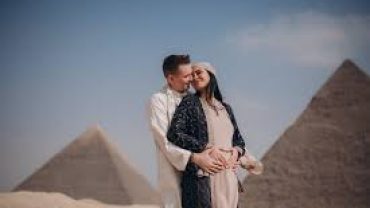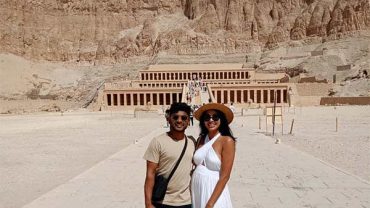Kom Ombo Temple, a marvel nestled on the banks of the Nile River in Egypt, stands as a testament to the ancient Egyptian civilization’s architectural prowess and religious significance. This unique temple is dedicated to two deities, Sobek, the crocodile-headed god, and Horus, the falcon-headed god, making it one of the rare double temples in Egypt. Dating back to the Ptolemaic dynasty, the Kom Ombo Temple offers a fascinating glimpse into the religious practices and beliefs of the time.
History and Significance
The history of Kom Ombo Temple dates back to the 2nd century BC during the reign of King Ptolemy VI Philometor. The temple is strategically located at a bend in the Nile, highlighting its importance in ancient trade routes and religious ceremonies. Dedicated to Sobek and Horus, each side of the temple mirrors the other, symbolizing the harmony between opposing forces. Sobek, associated with fertility and protection, and Horus, representing the sky and kingship, showcase the Egyptians’ intricate understanding of balance in their cosmology.
Beyond its architectural brilliance, the Kom Ombo Temple served as a hub for healing practices, hosting a complex of rooms believed to be a medical school. Hieroglyphs and reliefs inside the temple depict surgical instruments, emphasizing the temple’s dual role as a religious and medical center. This confluence of spirituality and healing highlights the intricate tapestry of ancient Egyptian life, making Kom Ombo a unique and multi-dimensional historical treasure.
Architectural Marvels
The architectural grandeur of Kom Ombo Temple captivates visitors with its impressive colonnades, hypostyle halls, and intricate carvings. The symmetry of the temple, reflecting the duality of its deities, is a remarkable feat of ancient engineering. The hypostyle hall, adorned with 10 columns on each side, leads to the sanctuary housing statues of Sobek and Horus. The detailed reliefs on the walls depict various religious ceremonies, offering a vivid tableau of ancient Egyptian life.
The outer walls showcase intricate carvings portraying historical events, including battles and the divine birth of the Pharaoh. The precision in design and execution highlights the advanced architectural knowledge of the ancient Egyptians. Exploring the nooks and crannies of Kom Ombo Temple is like stepping into a living history book, where each carving and column whispers tales of a bygone era.Explore also Karnak Temple.
Religious Practices and Rituals
The religious significance of Kom Ombo Temple is deeply rooted in the worship of Sobek and Horus. The temple hosted daily rituals, with priests conducting ceremonies to honor the deities. The sacred crocodiles, considered incarnations of Sobek, were kept in a special pool within the temple complex. Pilgrims seeking divine intervention would participate in ceremonies, offering prayers and gifts to ensure the favor of the gods.
The intricate hieroglyphs within the temple provide insights into the religious texts and spells recited during these rituals. The priests, adorned in elaborate ceremonial attire, would perform sacred dances and chants to connect with the divine forces. Kom Ombo Temple’s religious practices reflect the ancient Egyptians’ profound spiritual connection and their elaborate methods of seeking harmony with the gods.
Modern-Day Exploration
In the present day, Kom Ombo Temple stands as a captivating archaeological site, drawing visitors from around the world. Exploring the temple allows one to unravel the mysteries of ancient Egyptian beliefs and architectural techniques. Preservation efforts ensure that the intricate carvings and structures continue to narrate the tale of this dual temple.
Visitors can stroll through the expansive courtyards, marvel at the well-preserved reliefs, and contemplate the spiritual energy that still lingers within the temple’s walls. The site’s accessibility and the wealth of information provided by knowledgeable guides make Kom Ombo Temple a must-visit destination for anyone eager to delve into the rich tapestry of ancient Egyptian history and culture.
Artistic Expressions and Symbolism
Kom Ombo Temple’s walls are adorned with a tapestry of artistic expressions, each telling a unique story through intricate hieroglyphs and meticulously crafted reliefs. The symbolic significance of these artistic elements is a testament to the depth of ancient Egyptian culture. The carvings on the temple’s walls depict not only religious ceremonies but also scenes from daily life, emphasizing the interconnectedness of the spiritual and mundane.
The hieroglyphs, a form of writing combining logographic and alphabetic elements, serve as a linguistic key to understanding the beliefs and rituals associated with Sobek and Horus. The intricate symbolism in the artwork goes beyond mere decoration; it is a language that transcends time, offering a glimpse into the spiritual mindset of a civilization that held its deities in reverence. The mastery of symbolism at Kom Ombo Temple is an artistic legacy that continues to resonate with modern visitors.
Influence on Ancient Medicine
One of the unique aspects of Kom Ombo Temple is its connection to ancient Egyptian medicine. The temple complex includes a section believed to have been dedicated to medical practices, making it a pioneer in the integration of religion and healing. The reliefs within this medical area showcase surgical instruments, emphasizing the temple’s role as a center for medical education and treatment.
The link between the divine and the healing arts is evident in the depiction of medical procedures and instruments alongside religious iconography. This fusion of spirituality and medicine reflects the ancient Egyptians’ holistic approach to well-being. Kom Ombo Temple, in this regard, becomes not just a religious center but a testament to a society that valued the synergy between the sacred and the practical, setting a precedent for the integration of spirituality and healing in human history.
Conservation Efforts and Preservation
Preserving the legacy of Kom Ombo Temple is a paramount undertaking, considering its historical and cultural significance. Conservation efforts, spearheaded by archaeologists and preservationists, aim to safeguard the temple’s structural integrity and prevent further deterioration. The delicate carvings, susceptible to weathering and environmental factors, require meticulous care to ensure they continue to narrate the tales of ancient Egypt.
The use of modern technology, such as non-invasive scanning and 3D modeling, aids in documentation and restoration endeavors. These techniques allow experts to create digital replicas, providing a valuable resource for research and educational purposes. Additionally, controlled tourism measures and visitor guidelines contribute to the preservation of Kom Ombo Temple, striking a balance between making this historical marvel accessible to the public and safeguarding it for future generations.
Educational Significance
Kom Ombo Temple transcends its role as a tourist attraction; it is an open book of ancient Egyptian history and culture. Educational programs and guided tours not only showcase the temple’s architectural wonders but also delve into the religious and societal aspects of the time. Students and scholars alike have the opportunity to engage with the tangible remnants of an ancient civilization, fostering a deeper understanding of the interconnectedness of art, spirituality, and daily life.
By integrating Kom Ombo Temple into educational curricula, Egypt ensures that the wisdom of its ancestors is passed down to future generations. The site becomes a living classroom, where the walls speak volumes, and the stones whisper stories. In doing so, Kom Ombo Temple continues to fulfill its role as a beacon of enlightenment, bridging the temporal gap between the ancient and modern worlds.




Comment (0)